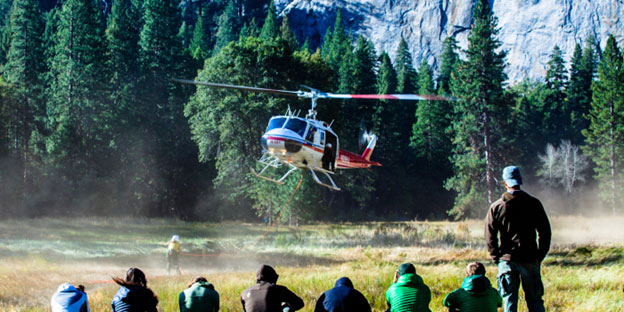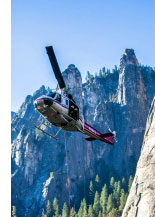
On Monday, September 19, 2015, at approximately 5:30 pm, Yosemite Search and Rescue (YOSAR) received a report that a climber had taken a 50-foot fall. The climber was on a climbing route called Lurking Fear, which is located on the western edge of El Capitan, and was reportedly was suffering serious injuries, including possible head trauma and a broken clavicle.
The reporting party was another climbing team on Lurking Fear. While cell service was poor, YOSAR was able to determine approximately where the climber was and vaguely what had happened. YOSAR used a spotting scope to locate the injured party approximately three quarters of the way up the route. Using a megaphone and hand signals, YOSAR was eventually able to make contact with the partner of the injured climber. From this initial size-up, the partner indicated that the injured climber had a possibly broken clavicle and had not lost consciousness. Given the late hour and the perception that the injured climber had not lost consciousness, YOSAR postponed rescue operations until the following morning.
 On Sunday, at 7 am, YOSAR began rescue operations out of El Capitan Meadow. Park Helicopter 551 performed a reconnaissance flight, which helped rescuers determine that lowering rescuers from the top of El Capitan would be incredibly difficult and potentially more hazardous than a short-haul mission using Helicopter 551. Short-haul missions involve suspending a rescuer 150-250 feet below the helicopter, flying them to the scene of the accident, and placing them directly onto the side of the cliff.
On Sunday, at 7 am, YOSAR began rescue operations out of El Capitan Meadow. Park Helicopter 551 performed a reconnaissance flight, which helped rescuers determine that lowering rescuers from the top of El Capitan would be incredibly difficult and potentially more hazardous than a short-haul mission using Helicopter 551. Short-haul missions involve suspending a rescuer 150-250 feet below the helicopter, flying them to the scene of the accident, and placing them directly onto the side of the cliff.
Helicopter 551 inserted two rescuers at the injured climber and the rescuers packaged the patient for extraction. Helicopter 551 then retrieved the injured climber, the two rescuers, and a substantial amount of the climber’s gear. The injured climber was then transferred to an ambulance. The partner of the injured climber was absorbed by another climbing team and continued to the top.
After speaking with the injured climber, rangers determined that the climber was using direct aid climbing (the climber was using specialized gear to make progress up the route). The last thing the injured climber remembered was placing a red micro cam and stepping into the ladder to weigh it. Speaking with other climbers on scene, it appears that the top piece of gear failed and proceeded to pull at least two more pieces before being caught by a number four cam. The uninjured partner was able to lower the climber to a ledge and then descend down to assist him. Whereas megaphone communications had led YOSAR to believe the climber had not lost consciousness, follow up interviews with adjacent climbing groups revealed that they had believed the injured climber had a severely deformed helmet and had been going in and out of consciousness, and that the climber had what appeared to be a broken clavicle.
The injured climber and his partner were joined by two additional teams of climbers. The fellow climbers reportedly monitored the injured climber through the night and stayed on scene until the completion of the short-haul mission the next day.
Lessons Learned
The placement of multiple questionable pieces of gear (which were used to provide protection in case of a fall) in a row was perhaps the main contributing factor to this accident. Perhaps most importantly, this is a reminder of how helpful helmets can be in preventing serious head trauma. According to medical personnel on scene, it is very likely that the climber’s head injuries would have been much more substantial had the climber not been wearing a helmet.
It is important to remember that climbing above ledges increases the likelihood of a lead climber fall causing significant injuries. In this accident, the lead climber was starting off a large and tiered ledge system that the climber may have struck during the fall. Climbers, especially at the end of the day when they are tired and mentally exhausted, are more prone to making mistakes and overlooking safety details. Being cognizant of your own fatigue— as well as your partner’s—is an important part of staying safe on the wall.
